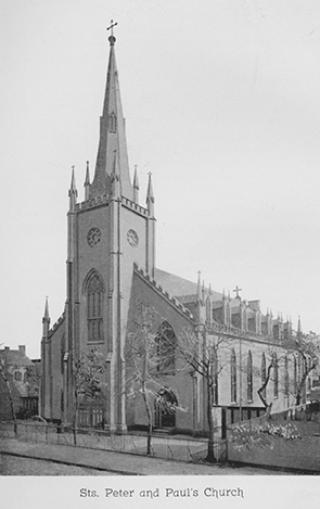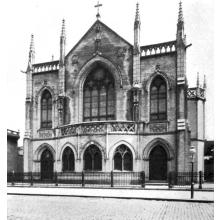Ss. Peter and Paul Church
(1848, Patrick Keeley)
Photo: NY Organ Project
This is the original church of Sts. Peter & Paul, Wythe Avenue between South Second and South Third Streets. Sts. Peter & Paul was the first Catholic parish in Williamsburg, and the third Catholic parish in Kings County1. Constructed in 1847, this church was the first church designed by Patrick Charles Keely, who went on to design hundreds of other Catholic churches throughout New York and the Northeast (by some accounts, Keely designed over 700 churches).
This was not, however, the first church for the parish. The first Catholic services in Williamsburgh (then with an “h”) were held in a private home on Bedford Avenue near South Third Street in 1837. Those services were conducted by a Father Bradley, a priest from St. Mary’s Church (Grand Street) in New York City. Soon after those services started, the nascent church rented a former stable located at the rear of lot fronting Grand Street, just west of Bedford Avenue. The first mass in this building was held in the summer of 1838, however this church closed a few months later when the visiting priest was unable to raise enough funds to support his work.2
In 1840, Rev. James O’Donnell was sent to Williamsburgh from St. Paul’s Church on Court Street (Brooklyn) to found a parish in the growing town to the north. O’Donnell purchased six lots on the northeast corner of Kent Avenue and North Eighth Street, and hired local builder John Brown to construct a frame church. The location chosen was at the time the outskirts of the growing town of Williamsburgh, which was then centered on the Southside. The new church, which accommodated about 500 worshipers, was constructed in the center of the 150’ x 100’ lot, and the area around the church was set aside for a graveyard. This new church - called St. Mary’s - was dedicated on June 27, 1840 by the Right Rev. James Dubois, the second Bishop of the New York Diocese.3
Rev. O’Donnell visited St. Mary’s weekly through 1844, when he was briefly succeeded by Rev. William P. Hogan, also of St. Paul’s. In September of 1844, Bishop John Hughes appointed Sylvester Malone as the first resident priest of St. Mary’s parish. Malone would go on to serve the parish for over 50 years. At that time the parish extended from Hallet’s Cove in Astoria (where Socrates Sculpture Park now sits) in the north to Myrtle Avenue in the south, and as far east as Middle Village.4
Malone’s first administrative task as priest was to pay off the $2,000 in debt the church had incurred for the construction of the North Eighth Street church. Once the finances were secure, he then embarked on the construction of a new church, which he desired to put in the 13th Ward (today’s Southside). In late 1845 or early 1846, Malone, through a parishioner, acquired a plot of land on Wythe Avenue between South Second and South Third Streets. At the time, there was considerable anti-Catholic sentiment among the largely Anglo-Protestant residents of Williamsburg, in particular among the growing group of nativists in the community. As a result, Malone sat on the property for 18 months, before he announced that the church would be moving its graveyard to the Southside and constructing a new church on North Eighth Street. The prospect of a graveyard in their midst was of more concern than the prospect of a Catholic church, and the hue and cry over the church subsided.5
Sts. Peter and Paul Church
(1902, George H. Stratton)
Photo: NY Organ Project
Malone hired Keely as the architect for the new church, and at the same time renamed the parish and church after Sts. Peter and Paul to avoid the growing confusion with St. Mary’s, New York, located directly across the river. Keely designed what would become his stock in trade - a gable-roofed Gothic church with a projecting tower carrying a tall steeple (it was described as being the first Gothic order church constructed in the Diocese of New York). The tower was 18’ square at the base and 70’ tall, with a steeple rising above to a total height of 150’. The 63’ wide by 104’ long body of the church had a gable roof, in this case with dormer windows, and seven large Gothic windows along each aisle. Unlike many of his later brick Gothic churches, Sts. Peter and Paul was more ornate in detail and finished in stucco to resemble brownstone.
The interior of the church was finished in what was described as the Tudor Gothic style, with faux finishes to resemble Italian marble.6 The stained glass windows in the aisle and over the doorways leading to the vestry were done by a Mr. Morgan7, likely George Morgan or one of his brothers, who were just starting their business in New York City.
The cornerstone for Sts. Peter and Paul was laid by Bishop Hughes on May 30, 1847, and the church itself was dedicated on May 7, 1848.8 The Keely church lasted just over half a century - in 1900, the church undertook a major renovation designed by architect George H. Streeton. The tower and steeple, deemed to be unsafe, were removed, and the front of the church was moved fifteen feet west toward Wythe Avenue. A memorial rose window dedicated to Father Malone was placed in the center of the new pressed brick and gray terra cotta facade. The gallery on the interior, which had extended around three sides of the church, was cut back to just the front of the church and the organ was rebuilt on either side of the rose window. The interior was completely refinished to resemble Nurmidian marble, and the “old” alternating current electrical system was replaced with direct current.9 This church too only lasted for about half a century - it was demolished in 1957 for the construction of the current church of Sts. Peter and Paul on South Second Street - depending on how you are counting, the third, fourth or fifth church in the lineage, and certainly the longest lasting.
- 1Some lists place Sts. Peter and Paul sixth on the list of Brooklyn parishes, dating it to 1844 - the date that the first resident priest was appointed. 1840 appears to be a more accurate date, however, putting Sts. Peter and Paul one year earlier than Most Holy Trinity on Montrose Avenue, which was founded in 1841.
- 2Memorial of the Golden Jubilee of the Rev. Sylvester Malone (Brooklyn: Privately Printed, 1895), 15.
- 3Ibid, 15.
- 4Ibid, 18.
- 5Ibid, 19.
- 6Ibid, 21.
- 7Ibid, 21.
- 8Ibid, 21.
- 9“Solemn Service Arranged: Sts. Peter and Paul’s Congregation Will Celebrate Patrons’ Day and Completion of Extension”, Brooklyn Daily Eagle, June 28, 1902, 2.

